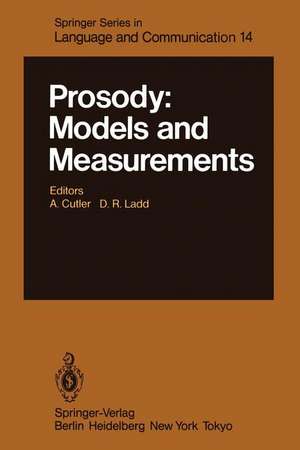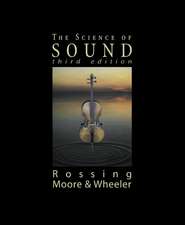Prosody: Models and Measurements: Springer Series in Language and Communication, cartea 14
Editat de A. Cutler, D. R. Ladden Limba Engleză Paperback – 19 noi 2011
Din seria Springer Series in Language and Communication
- 15%
 Preț: 637.59 lei
Preț: 637.59 lei - 15%
 Preț: 637.59 lei
Preț: 637.59 lei - 15%
 Preț: 636.30 lei
Preț: 636.30 lei - 15%
 Preț: 643.84 lei
Preț: 643.84 lei -
 Preț: 386.22 lei
Preț: 386.22 lei - 18%
 Preț: 724.80 lei
Preț: 724.80 lei -
 Preț: 377.73 lei
Preț: 377.73 lei -
 Preț: 388.72 lei
Preț: 388.72 lei -
 Preț: 385.62 lei
Preț: 385.62 lei -
 Preț: 379.48 lei
Preț: 379.48 lei -
 Preț: 387.58 lei
Preț: 387.58 lei - 15%
 Preț: 635.15 lei
Preț: 635.15 lei -
 Preț: 383.12 lei
Preț: 383.12 lei - 15%
 Preț: 632.37 lei
Preț: 632.37 lei -
 Preț: 384.31 lei
Preț: 384.31 lei - 15%
 Preț: 650.04 lei
Preț: 650.04 lei -
 Preț: 386.00 lei
Preț: 386.00 lei -
 Preț: 402.00 lei
Preț: 402.00 lei - 18%
 Preț: 729.53 lei
Preț: 729.53 lei -
 Preț: 387.20 lei
Preț: 387.20 lei - 5%
 Preț: 725.59 lei
Preț: 725.59 lei - 15%
 Preț: 635.15 lei
Preț: 635.15 lei - 15%
 Preț: 631.53 lei
Preț: 631.53 lei -
 Preț: 396.24 lei
Preț: 396.24 lei -
 Preț: 387.96 lei
Preț: 387.96 lei - 15%
 Preț: 640.24 lei
Preț: 640.24 lei -
 Preț: 378.54 lei
Preț: 378.54 lei
Preț: 634.68 lei
Preț vechi: 746.69 lei
-15% Nou
Puncte Express: 952
Preț estimativ în valută:
121.44€ • 127.14$ • 100.49£
121.44€ • 127.14$ • 100.49£
Carte tipărită la comandă
Livrare economică 05-19 aprilie
Preluare comenzi: 021 569.72.76
Specificații
ISBN-13: 9783642691058
ISBN-10: 3642691056
Pagini: 180
Ilustrații: XII, 162 p.
Dimensiuni: 155 x 235 x 9 mm
Greutate: 0.26 kg
Ediția:Softcover reprint of the original 1st ed. 1983
Editura: Springer Berlin, Heidelberg
Colecția Springer
Seria Springer Series in Language and Communication
Locul publicării:Berlin, Heidelberg, Germany
ISBN-10: 3642691056
Pagini: 180
Ilustrații: XII, 162 p.
Dimensiuni: 155 x 235 x 9 mm
Greutate: 0.26 kg
Ediția:Softcover reprint of the original 1st ed. 1983
Editura: Springer Berlin, Heidelberg
Colecția Springer
Seria Springer Series in Language and Communication
Locul publicării:Berlin, Heidelberg, Germany
Public țintă
ResearchCuprins
1. Introduction. Models and Measurements in the Study of Prosody.- 1.1 Concrete and Abstract Accounts of Prosody.- 1.2 Illustrating the Two Approaches.- 1.3 Implications of the Two Approaches.- 1.4 The Contributions.- 1.5 The Purpose of an Interdisciplinary Volume.- 2. A Generative Model of Intonation.- 2.1 The Model.- 2.2 Application to Swedish, Greek and French.- 2.3 Comparison.- 2.4 The Model Applied to Questions and Pragmatic Effects.- 3. Two Issues in the Prosody of Standard Danish.- 3.1 Introduction.- 3.2 Sentence Accent.- 3.3 The Representation of Sentence Intonation.- 4. Peak Features and Overall Slope.- 4.1 Introduction.- 4.2 The Peak-Feature Model.- 4.3 Cross-Classification and Functional Relatedness.- 4.4 Peak Scaling and Declination.- 4.5 Summary.- 5. Language-Independent Prosodic Features.- 5.1 Introduction.- 5.2 Language-Independent Similarities.- 5.3 Prosodic Differences Among Languages.- 5.4 Conclusion.- 6. Prosodic Structure and the Given/New Distinction.- 6.1 The Given/New Distinction.- 6.2 Extensions of the Given/New Distinction.- 6.3 An Experimental Study of Intonation and Information Structure.- 6.4 Conclusion.- 7. Speakers’ Conceptions of the Function of Prosody.- 7.1 Introduction.- 7.2 The Prosody of Repair.- 7.3 The Repair of Prosody.- 7.4 Conclusion.- 8. Structures and Categories in Prosodic Representations.- 8.1 Intonation and Universal Grammar.- 8.2 Phonetic Representations of Intonation.- 8.3 Phonological Representations.- 8.4 Conclusion.- 9. Temporal Predictability in the Perception of English Speech.- 9.1 Stress and Rhythm.- 9.2 P-Centres and Rhythm.- 9.3 Rhythm and Temporal Predictability.- 9.4 Modelling Rhythmic Structure.- 9.5 Summary.- 10. Prosodic Structure Above the Word.- 10.1 Introduction.- 10.2 Construction of ProsodicCategories.- 10.3 Intonation Phenomena.- 10.4 Ambiguity and Potential for Disambiguation.- 10.5 Conclusions.- 11. Comparative Notes on Terms and Topics in the Contributions.- 11.1 Accents.- 11.2 Domains.- 11.3 Grids.- 11.4 Lines.- 11.5 Tones.- References.- Name Index.















